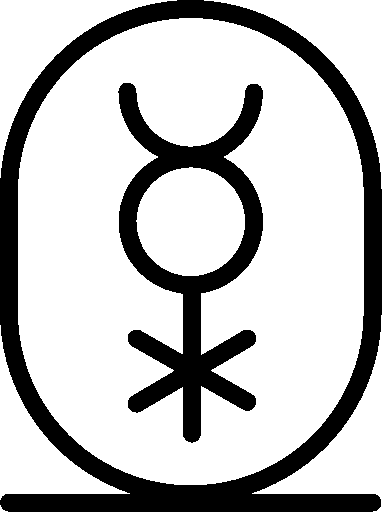I think that my tarot might be too clean. It’s too pure, too holy, too spiritual, too good. If I don’t take care, I will miss other important parts of my life: the dirty, messy, materialistic, gross, shameful, deplorable, offensive, disgusting, vulgar, bad, sick aspects. There are a lot of parts of me that I don’t like, and a balanced view of spirituality ought to take that into account. It’s part of my culture—and perhaps even part of my psyche—to only like the nice and neat parts of me and therefore to prefer a nice and neat but phony interpretation of the Holy Tarot.
Then again, if I look at other people’s spotless tarot collections, especially on YouTube or other social media, I start to realize I might not be such a neat tarot reader after all: my cards are stuffed into drawers, shelves, boxes, and basements; an uncatalogued amorphous mass collected over three decades and spread among as many houses and cities. Many decks are in zip-lock bags as I lost or messed up the original boxes. Absolutely unpresentable—not unlike my real life, with many things stuffed away into dark corners, and somehow barely not falling apart.

(public domain image found on Sacred Texts)
In my youth I often listened to David Baerwald’s album Triage (1992), and the song A Bitter Tree describes how messy tarot readers can become:
I saw my father drunk and helpless
—David Baerwald, A Bitter Tree, from the album Triage, A&M Records, 1992
And he was lying on the floor
He was naked drunk and helpless
And he was lying on the floor
[…]
The room was strewn with tarot cards
Empty bottles lined the wall
I don’t like to drink, but I too often strew cards here and there.
My tarot is too precious
One the one hand, today tarot is cheap and easily available. It’s not as special and precious anymore. That’s good.
On the other hand, the cards have become more and more precious: stunning illustrations by professional artists, produced by professional designers, gilded edges, lavish boxes, extravagantly printed, a collectible commodity. And that’s fine because it shows that tarot is part of our culture, which is a consumerist culture.
But modern tarots sometimes seem like Disney princesses: all pink and glitter, and no sweat or swearing. A person trying to be a Disney princess is a phony caricature, deserving of our pity—and a tarot that tries to be a Disney princess might just be as fake and untrustworthy. (Sometimes the Disney princess is a grim, dark, and gloomy Goth princess, and that is equally unbalanced.)
I will recommend a totally boring and predictable list of tarot deck styles that I believe are balanced:
- Waite-Smith Tarot, 1909 (a. k. a. Rider Tarot): Unfortunately many derivatives remove “dirty” symbols (such as nudity or blood), and add comforting kitsch imagery. The images used to illustrate this article are from this deck.
- Crowley-Harris Tarot, 1944 (a. k. a. Thoth Tarot): Some people (who should know better) spread the malicious rumor that Crowley might have been a Satanist, but if you are afraid of finding Satan inside this deck, you will be disappointed: the strangely clean devil card depicts a charming goat with psychedelic flowers on his head, plus a giant golden penis.
- Tarot de Marseille, 17th century: It’s dirtier than the others because of its mundane origin as a game, and its simple style: there is no snooty magus—he’s a lowly juggler, a trickster. And the fool exposes his naked butt, lest we forget that we all have (and often all are) assholes.

(public domain image found on Sacred Texts)
Barriers to the true picture
Frankly, this idea of mine is not very original: Many people have noticed that we often tend to prefer the nicer aspects of tarot cards, and like to ignore the more problematic aspects. That’s why in many tarot books there are “negative”, “reversed” and/or “shadow” keywords associated with each card.
I constantly put up barriers:
- Wishful thinking: My life is full of problems, and I would prefer the tarot to report that they will disappear soon. Better concentrate on the nice symbols and hope for the best.
- Fear of change: If I look too closely at the cards I might find an answer I already know but don’t want to see. Who knows, maybe I’ll even find out I have to change something in order for something to change.
- Pride: I somehow suspect that I am not as smart, competent, lovely, or trustworthy as I wish to be (or wish to be seen), but I am so used to exaggerating my good qualities and minimizing my bad qualities that I often continue to do so even when there is no one left to fool.
- Fear of intimacy: Often I feel alone. I would feel better if I talked to a family member, a lover, or a friend, or had sex, or did something nice for somebody else. But to truly combat loneliness I would have to open up to another person—and to myself. How am I supposed to keep this high and mighty image I have of myself intact if I become more open and honest? That seems like a steep price to pay for looking closely at some tarot cards, so better not look that closely.
- Fear of loneliness: Once we better know who we are, and allow change into our lives, we might need to adjust our social lives, our relationships, our careers—things we often built over an entire lifetime. That might seem like a good reason to not listen when the tarot tells us more about us than we can fit into our current lives.
- Pain: Some things just hurt to think about. Sometimes it is hard to understand what purpose the pain serves. It’s natural to shy away from it.
Those barriers will always be there to protect me from being overwhelmed, but I want to keep in mind that I myself am responsible for them.
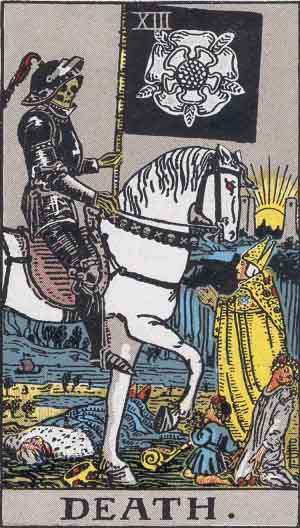
(public domain image found on Sacred Texts)
Death will kill you
Some cards seem easy to understand. Take card № 13–Death. If we look at it, it is quite simple: a skeleton or a decaying corpse, usually armed with a scythe. It clearly reminds me that everything that can die, will indeed die.
Most people who don’t know much about tarot are almost superstitiously afraid of this card. I mean, of course: it’s death. Many professional tarot readers even remove it from their decks in order to not scare their clients.
But how do experienced tarot readers tend to interpret Death? Oh, not too bad, it’s okay, it’s a “transformation”, a “new beginning”, a “renewal”. Which is obviously true, but still: for something to transform something else has to go—for good, forever, gone. That loss right there is death—true loss, out of which transformation may result.
Now I usually do like transformation, yet I’m terribly afraid of loss. Death will teach me both.
And if you don’t even believe in death—as we spiritual people sometimes pretend to do—you now know why you are looking at the tarot card depicting it. It’s trying to tell you something.
The Devil is diabolical
Card № 15–The Devil is often reduced to the idea of addiction by authors and deck creators. Basically, the devil is a chain smoker with a hangover. And that certainly is a fitting metaphor, as taking harmful but fun substances—one more drink, one more hit of a drug—can feel like being possessed by some powerful devil. In German you ask “Which devil has ridden you?” (roughly “What the hell came over you?”) if somebody made an awful (and often selfish) mistake.
But the card The Devil is more than choosing to smoke weed instead of cleaning your apartment. It’s far more sinister. The Devil is where our darkness lives, our lies, our selfishness, our irrationality, our irresponsibility, our greed, the shameful and hidden parts of our personality. In the words of the Red Hot Chili Peppers, our dark necessities—but: “The darkness helps us all to shine.”
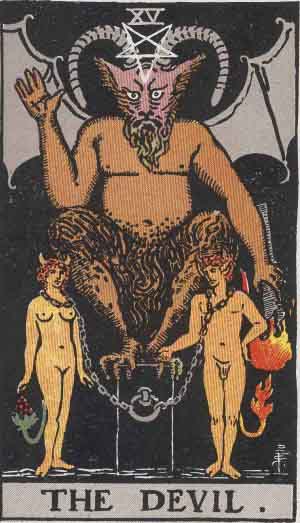
(public domain image found on Sacred Texts)
So, if you see the devil card and pity yourself, thinking “Oh poor me, I am powerless, in the grip of an evil force”, you might want to add “or I’m being evil myself, irrational, selfish, devilish, I’m hiding things from myself and others, I’m capable of being a monster.”
And if your reaction is, oh, I don’t believe in sin, there is no true evil in the world, and I am certainly no monster—why the hell do you think there is a devil staring at you from your little tarot cards, with his dirty, knowing look?
Smearing dirt on your tarot
The original title of this article was “Smear shit on your tarot”. Although I think that’s a bad title for an article (as this is my professional website) (also my husband disapproves of swear words) I still think it is good advice. If your tarot smells too nice, beaming and gleaming all pristine, something is off and needs to be balanced out.
The Swiss occultist and musician Akron (a. k. a. Charles Frey, 1948–2017) had mastered smearing dirt on holy things. His ideas often incorporated Swiss psychologist Carl Gustav Jung’s concept of the Shadow (the shameful, antisocial, dirty parts of our being hidden from our everyday conscious Ego). He created two tarot decks that added “dirty” cards:
- The Baphomet Tarot by Akron, with images by Hans Rudolf Giger (originally published by Urania in 1992, expanded in 2009)
- The eponymous Akron Tarot by Akron, with images by Siegfried Otto Hüttengrund (Urania, 2004)
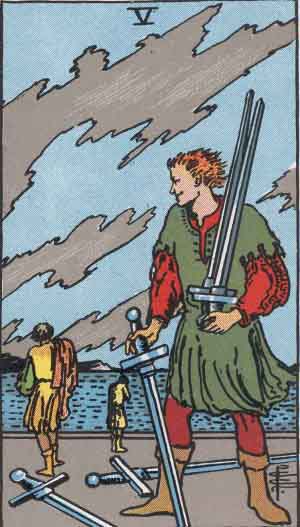
(public domain image found on Sacred Texts)
New “dirty” cards by Akron
To the Baphomet Tarot Akron added a card called The Virus or The Creator-Virus. I can’t show the image here as it is shockingly (and suitably) dark and erotic, with skulls, horns, erections, mutations, grime and crime, pudenda and penetrations—it’s bona fide Dirty with a capital D.
[By the way, I can’t show any cards from Akron’s publisher, as they want web authors to sign some silly contract, which is funny, because they think that we are the ones profiting from them …]
To his Akron Tarot he added three new cards, all more or less dirty:
- Two extra devil cards numbered ⅩⅤ/ⅰ and ⅩⅤ/ⅱ (which are printed on the same physical card and so are reversals of one another), called The Black Goddess and The Scarlet Anima. That means Akron’s Tarot has three devils: quite an unholy trinity!
- He also added The Dark Child, featuring a cranky little baby demon.
The keywords he associates with his new cards will demonstrate just how unpleasant and unholy they are:
- The Devil: suppression, hell, shadow projections
- The Black Goddess: cruelty, vindictiveness, female dominance
- The Scarlet Anima: addiction, entanglement, masochism
- The Dark Child: withdrawal, rejection, abusive love [my translations from Akron’s original German, MG]
- The Virus: this card is called an “occult monster” in its accompanying booklet
Although I don’t think that the tarot needs new cards at all, as all of these “dark” meanings are already well integrated into it—but instead we tarot readers might sometimes need new cards, to see the old cards with new eyes.
All breath and no fart
In life we often adore our breathing, but are ashamed of our farting. Both keep us alive, and both are necessary in order to be human.
If you view life—or your tarot—as all breath and no fart there is a literal disconnection between above and below. According to the Emerald Tablet of Hermes (one of the famous foundational texts of the Western esoteric tradition) this is a large part of what spirituality is all about: as above so below. One might say life is our holy quest for the connection between above and below. Our breaths and farts will always be with us on this journey—and they also symbolize this journey—until our bodies break apart.
If we look closely, if we dare to look at all, the tarot might reflect this gaseous duality.
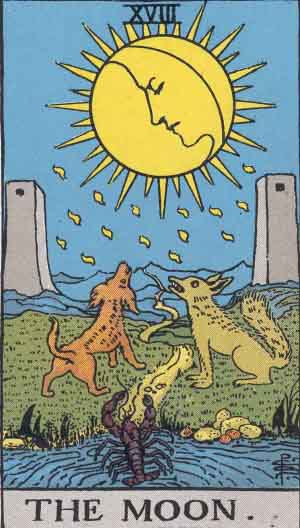
(public domain image found on Sacred Texts)
Is this about “shadow work”?
Shadow work is getting more and more popular in spiritual circles, inspired by the important and beloved ideas of Carl Gustav Jung.
Yes, sure, plan to do some shadow work, one of these days. It’s going to be worth your while. In fact, I recommend Benebell Wen’s work on this topic (and any other topic): the occult author and corporate attorney has produced an impressive and free self-guided workbook for shadow work with tarot or oracle cards (2016).
She defines shadow work as “pulling into the light all that you would rather conceal, so that you can uncover your greatest innate gift.” So you can imagine how dirty this might become!
Wen reminds us that “shadow work is a lifelong endeavor, with many facets.” About her workbook she writes: “This workbook is by design limited in scope. It is only one self-guided session of shadow work.” A structured session of one afternoon or evening looking at your shadow will be instructive and transformative, in my personal opinion and experience. Do it, if it sounds at all sexy to you. Do it often.
But I am recommending something far more simple and less involved: look at all the dirty stuff right now, in your daily life, and your daily spirituality.
Simply always ask yourself:
- What am I seeing?
- What am I liking?
- What am I disliking?
- What does this teach me about myself that I either don’t know yet, or keep trying to forget?
- or simply: Where is the dirt?!
Train this while using your tarot cards in divination, magic, and meditation, and you will benefit in all life areas. And if you find the time and the strength, do a proper session of shadow work. But don’t delay in looking for dirt in your life: it’s real and it’s right here.
How to mess up your tarot
- First of all, look at the card. Don’t treat it as a sign, a cipher, or a shorthand. Instead first treat it as an image, and look at it as you would study a stranger’s face in order to find out if he is friend or foe. Look at it as if you have never seen it before. As Waite famously wrote in his 1909 Key to the Tarot: “The true Tarot is symbolism; it speaks no other language and offers no other signs” (page 8). The symbols are in the image. Look at the image.
- Look at yourself. You will like certain things about the image, others will not speak to you at all—and some things will irritate you. C. G. Jung writes in his biography: “Everything that irritates me about others is able to teach me about myself” (Erinnerungen, Träume, Gedanken, 1962, page 250, my translation).
- Take unfavorable cards seriously. If you don’t like a card, or if you “draw a blank”, i. e. the card doesn’t seem to want to be looked at at all, chances are you have found something very important. Rejoice. Put the card in a prominent place, meditate upon it, journal about it. Find out why it seems bad or strangely empty to you. You may have stumbled upon a gruesome but liberating truth.
- Think about the depicted people in the third person, describe everything you see and feel: “He seems aggressive”, “she seems short-sighted”, and of course you’ll be talking about yourself most of the time.
- Force yourself to see the bad in a card. If you find yourself very much liking a card, such as № 6–The Lovers, ask yourself “Is there something bad about this card?” How would you describe the card you are looking at in negative terms, as depicting something unpleasant, or as a bad omen? If you can’t find many negative meanings about the card, look up shadow or reversed meanings in your books or on the web, and reflect why you didn’t seem to want to see it. What are you hiding from yourself?
- Force yourself to see the good in a card. Sometimes we are repulsed by a symbol because it depicts our hidden desires, often about sex or power, or other things we never seem to get right. Maybe you realize that you like something which you aren’t supposed to like. Dirty you.
- Be grateful for the tarot. This life is difficult, confusing, and short. We will not get many opportunities to explore ourselves. Cherish every moment you have with yourself and your tarot cards. They will show you your soul, simple as that. Respect the tarot by being honest to yourself, and it will respect you by slinging lots of dirt at you.
In short, use every image to ask yourself where the dirt is.
- Bonus tip: Literally mess up your tarot. Use a permanent marker and take notes on the face of the card. Do you know all the values and meanings of the Hebrew letters? Did you find lists in books or on the web where interesting ideas are connected to the cards? Does the guide-book to your favorite deck have more interesting content than the cards themselves? Write that stuff directly on the cards. That always helps me to see cards as tools instead of collectibles.
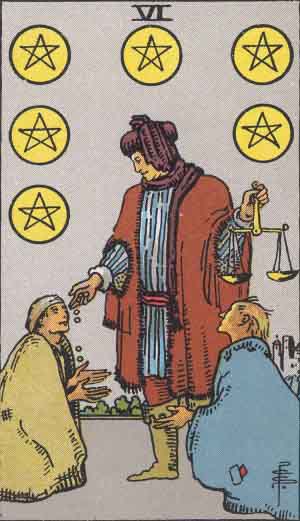
(public domain image found on Sacred Texts)
Keep both the clean and dirty meanings in mind
Part of this article is tongue-in-cheek, because at the same time, these clichéd, nice, reductionist, harmless, clean interpretations—Death is merely transformation, The Devil is merely addiction—are true.
They point to higher truths: at least according to many spiritual traditions death truly is a transformation, not an ending, and the devil truly is created by myself, and doesn’t represent evil at all.
But still: Only by acknowledging the terrible images can I understand the magnificent symbols and realize higher meanings. If I am afraid of getting my hands dirty by digging deep, chances are I won’t find much of real interest.
So don’t let this article distract you from the higher esoteric meanings of the tarot—without striving both very high and very low tarot wouldn’t be tarot—but let it remind you of the human face of its symbols which seem to me to be a pretty good mirror of our own lives. There is so much to see! Explore the unpleasant, shameful, smelly aspects of the tarot that are staring right at you. And if you can’t find those dirty aspects, smear some shit on your tarot; we are full of it most of the time anyway.
Further reading
- Hajo Banzhaf & Akron, The Crowley Tarot: The Handbook to the Cards, 1991 (translated into English 2003): As in all books by Akron, the concept of the so called “shadow” (from the ideas of C. G. Jung) features prominently. Combined with the no-nonsense style of Banzhaf, and the breathtaking work by Crowley and Harris, this influential book is a modern Tarot classic. If you read German, you might find the book and deck set Der Akron-Tarot (2004) interesting, as it is Akron’s final word on Tarot and the shadow.
- Carl Gustav Jung, Man and his Symbols, 1964: If you only ever read a single book on psychology, this could be it. It’s easy to read, but of hair-raising depth. It explains most things any person needs to know about the human psyche, in all its dirt and glory, and might just amaze you.
